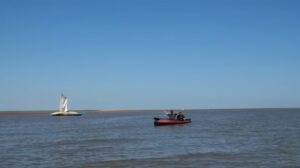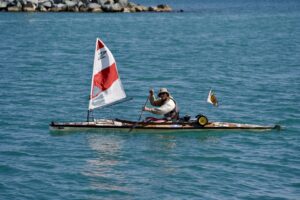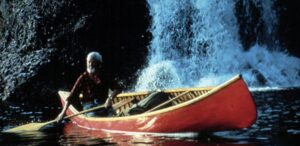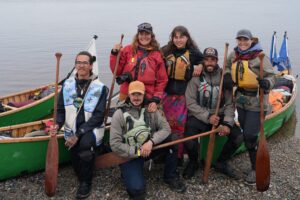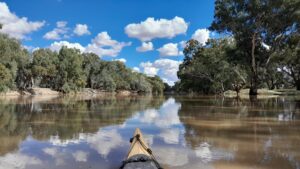Madison Eklund had always been an active hiker, climber, and kayaker, but she’d never undertaken a mega-journey before. But when she and her husband were due to move because of his job in the military, “I knew I’d be losing the mountains, forests, and in a way, a part of myself,” she said. Thus, the idea of 2,400km solo paddle from Minneapolis to Hudson Bay was born.
She initially wanted to kayak the length of the Red River from South Dakota to Manitoba. But when she started talking to locals about it, many mentioned a much longer, historic trip, from Minneapolis to Hudson Bay.

Photo: expeditionalpine/Facebook
Two women had done the same route fairly recently. Eklund began reading everything she could find on their journey and went to their book launch. Two men, Eric Sevareid and Walter Port, originally did the route in 1930, so she also read Sevareid’s book, Canoeing with the Cree.
‘My kind of crazy’
The more she read, the more she could see herself doing it. “It was my kind of crazy,” she told ExplorersWeb in June.
When she reached York Factory in Hudson Bay, she became the fourth expedition and the first soloist to complete the route.
“Honestly, this was never about being the first soloist on this route. It just kind of evolved into that…I genuinely looked for a partner for this trip but ultimately could not find one. I’m very comfortable on my own in the backcountry, so it wasn’t that big of a deal for me.”

Photo: expeditionalpine/Facebook
Eklund first started kayaking at the age of six. “The neighbor’s son would always go out kayaking. I thought it looked so cool and fun and wanted to do it, too. I guess I never shut up about it, because my grandparents finally went and asked the neighbors if I could borrow their kayaks…They agreed, and my addiction started,” she told The Citizen.
She began the expedition on May 7 from Fort Snelling, at the junction of the Mississippi and Minnesota Rivers. From here, she paddled upstream through a chain of lakes to the Red River. She followed this across the Canadian border and continued northward along it.
Next, she traversed Lake Winnipeg, then picked her way along along the Berens and Hayes Rivers. Finally, after four-and-a-half months, she arrived at York Factory on Hudson Bay. (Note that she did meet and join another party of paddlers in the upper reaches of Manitoba, so by most adventure standards, her trip was not strictly solo.)

Photo: expeditionalpine/Facebook
Eklund’s first challenge was planning the expedition. The long distance and number of waterways required a lot of map study. She had to organize crossing the border into Canada and stuff all the gear needed for all those months in her kayak. She also lined up places to stay along the route, as a break from camping. Amid all this, she was also packing with her husband to move across the country.

Photo: expeditionalpine/Facebook
Diet challenges
She had to work harder to plan her food than most do. Eklund suffers from celiac disease, and although usually manageable, gluten-free food is not always easy to find off the beaten track. She worked with a dietician to plan her meals and make sure she was getting enough calories to keep her going. And by shipping supplies to different points along her route, she did not have to rely on the food available in small towns.
She did train specifically for the journey but relied on her general fitness. Her past hiking had taught her that there was no way to effectively prepare for being active 12 hours a day.
“No one- to two-hour gym routine compares to eight to twelve hours of repetitive motion in a boat, other than doing it for real,” she said in an interview. “I did go to the gym, but it didn’t do much. The parts I worked on still hurt at the start, and there were many muscles I didn’t expect to hurt that did.”

Photo: expeditionalpine/Facebook
Once she started paddling, her biggest concern was the whitewater, while her family worried about possible encounters with bears. Both fears were unwarranted. The whitewater that she chose not to attempt was easy to portage around. And no uncomfortable wildlife encounters occurred.
Black flies
Still, there were unexpected challenges. Although she had no problems with larger wildlife, she was almost eaten alive by black flies as she paddled through the wetlands farther north. Despite her best attempts to cover up, she ended up covered in welts.
The heavier kayak — chosen for its stability — was often a pig to portage. “[Even] dragging the boat [can be] hard, because mud suctions it down, making it feel like…double or triple its actual weight.”
She experienced blistering heat, high winds, choppy waters and was on tornado watch seven times during those nearly five months. Finally, there was the loneliness. Eklund did not think that it would affect her as much as it did. Her husband tried to motivate her as much as possible, but sometimes communication was difficult because of her remote location.

Photo: expeditionalpine/Facebook
Now in her new home, Eklund describes the journey as a “painfully beautiful and awesome experience.” She calls the people she met along the way her “river angels”. Many came to chat, offer food or a place to stay. One family took her in for two weeks when weather forced her off the river during spring flooding.
Though she wouldn’t tackle this route a second time, she admits that other ideas are playing in her head. The journey may have awakened in her a new love of long-distance kayaking.


